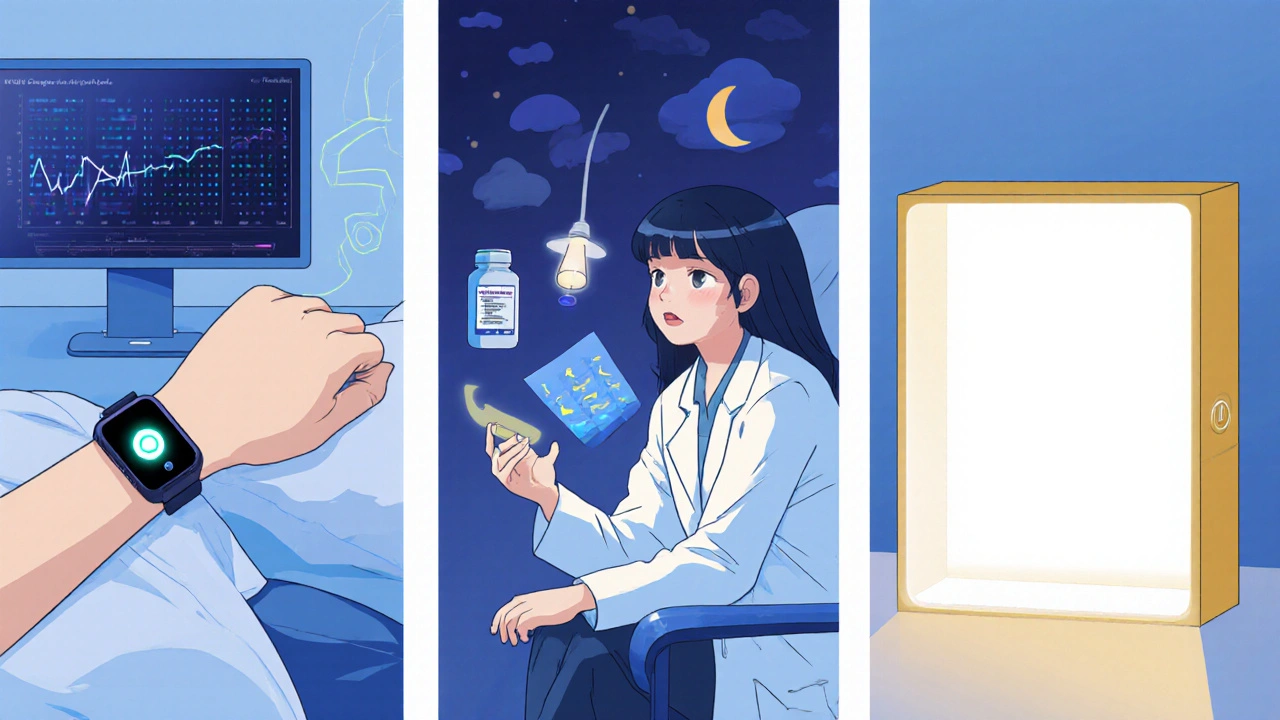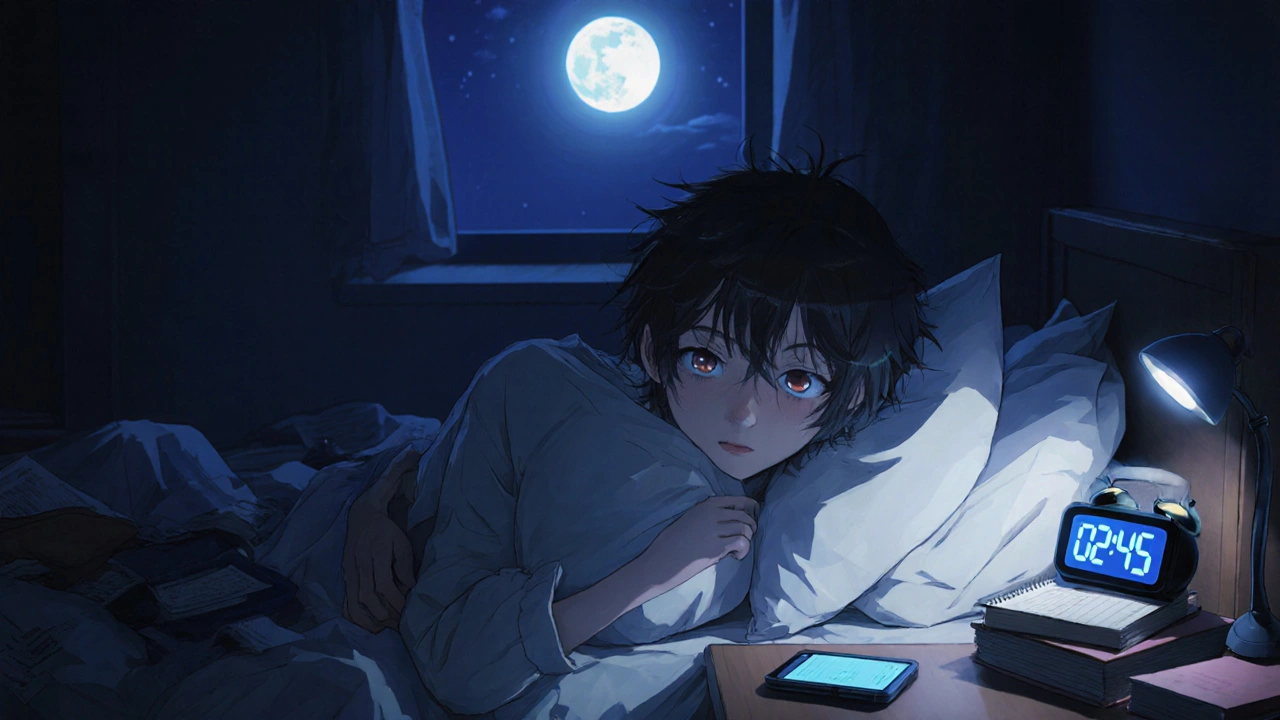DSPS Sleep Phase Adjustment Calculator
Adjust Your Sleep Schedule
Calculate your optimal morning light exposure timing to help shift your sleep phase earlier based on your current and desired sleep schedule.
Ever wonder why you can’t fall asleep until the early morning, no matter how tired you feel? You’re not lazy - you might be dealing with Delayed Sleep Phase Syndrome, a circadian rhythm sleep‑wake disorder that pushes your internal clock several hours later than society’s typical schedule. It’s a hidden epidemic affecting millions, especially teens and young adults, and it shows up as chronic insomnia, missed classes or work, and a constant feeling of being out of sync.
What Exactly Is Delayed Sleep Phase Syndrome?
DSPS is classified under the broader umbrella of Circadian Rhythm Disorders. Unlike occasional “night owl” habits, DSPS is a biological misalignment where the body’s master clock - located in the hypothalamus - tells you to sleep and wake at times that clash with the 9‑to‑5 world. The disorder often begins in adolescence, peaks in the early 20s, and can linger if left untreated.
Key Signs That You Might Have DSPS
- Consistently falling asleep after 2 am and waking after 10 am, even on weekends.
- Difficulty initiating sleep despite feeling exhausted.
- Daytime sleepiness, especially during early‑morning meetings or classes.
- Reduced performance at work or school because you’re forced to operate on a schedule that feels foreign.
- Social isolation due to conflicting sleep patterns with family and friends.
These symptoms differ from simple insomnia because the underlying issue isn’t anxiety about sleep; it’s a shifted internal clock.
Why Does It Happen? Common Causes and Risk Factors
Scientists point to a mix of genetics, environment, and lifestyle:
- Genetics: Family studies show a higher prevalence among relatives, suggesting a hereditary component linked to clock‑gene variants.
- Light Exposure: Evening exposure to blue light from phones or laptops suppresses Melatonin production, delaying sleep onset.
- Social Factors: Irregular schedules, late‑night socializing, and shift work can reinforce a later phase.
- Chronotype: People naturally inclined toward a “night owl” chronotype are more prone to DSPS.
- Psychological Stress: Anxiety and depression can exacerbate the misalignment, creating a feedback loop.
How Professionals Diagnose DSPS
Diagnosis isn’t based on a blood test; it relies on a detailed sleep history and objective measurements:
- Sleep Diary: Patients log bedtime, wake time, and daytime sleepiness for at least two weeks.
- Actigraphy: A wrist‑worn device records movement to infer sleep‑wake cycles over several days.
- Polysomnography (PSG): In a sleep lab, PSG measures brain waves, eye movements, and breathing to rule out other sleep disorders.
- Dim‑Light Melatonin Onset (DLMO): A specialized test that pinpoints when melatonin levels rise, indicating the body’s biological night.
These tools help differentiate DSPS from insomnia, delayed bedtime habits, or other circadian rhythm disorders.

Treatment Options: From Light Therapy to Behavioral Strategies
There’s no one‑size‑fits‑all cure, but a combination of approaches can shift your clock earlier:
| Intervention | How It Works | Typical Duration |
|---|---|---|
| Bright Light Therapy | Exposes you to ~10,000 lux of white light each morning | 30‑45 min for 2‑4 weeks |
| Melatonin Supplementation | Low‑dose melatonin taken 3‑5 hours before desired bedtime | 5‑10 days, then taper |
| Cognitive Behavioral Therapy for Insomnia (CBT‑I) | Addresses sleep‑negative thoughts and reinforces consistent schedules | 6‑12 weekly sessions |
| Chronotherapy | Systematically delays sleep time by ~1 hour each night until a desired phase is reached | Varies; supervised only |
| Lifestyle Tweaks | Limits evening screen time, establishes bedtime rituals, and schedules regular meals | Ongoing |
Bright light exposure in the early morning is the cornerstone. It suppresses melatonin and cues the suprachiasmatic nucleus to advance the sleep phase. Conversely, dim light in the evening helps preserve melatonin production.
Practical Daily Routine to Re‑Set Your Clock
- Morning Light: Step outside within 30 minutes of waking. If natural light isn’t possible, use a light‑box calibrated to 10,000 lux.
- Consistent Wake‑Time: Even on weekends, get up at the same hour to reinforce the new rhythm.
- Limit Blue Light After 7 pm: Use amber filters or “night mode” on devices, and consider blue‑blocking glasses.
- Melatonin Timing: Take 0.3-0.5 mg of melatonin 4 hours before the target bedtime for the first week.
- Pre‑Sleep Routine: Warm shower, reading a physical book, or gentle stretching signals your body it’s time to wind down.
- Exercise Timing: Aim for moderate activity before 6 pm; late‑night workouts can push the clock later.
Stick to this schedule for at least 2‑3 weeks before judging success. Patience is key - the body’s internal pacemaker adjusts slowly.
When to Seek Professional Help
If you’ve tried self‑help for a month and still can’t sleep before 2 am, or if DSDS is affecting school, work, or mental health, book an appointment with a sleep specialist. They can order actigraphy, assess for comorbid conditions like anxiety, and prescribe tailored light‑therapy protocols.

Potential Complications of Untreated DSPS
- Academic or Job Performance Decline: Chronically missed mornings lead to lower grades or reduced productivity.
- Mental Health Impact: Persistent sleep deprivation raises risk for depression and anxiety.
- Metabolic Effects: Irregular sleep timing is linked to weight gain and insulin resistance.
- Social Isolation: Incompatible schedules can strain relationships.
Addressing DSPS early not only restores sleep but also mitigates these long‑term health risks.
Frequently Asked Questions
Is Delayed Sleep Phase Syndrome the same as insomnia?
No. Insomnia is difficulty sleeping despite a normal internal clock, whereas DSPS is a shifted clock that makes conventional bedtime impossible. Treating DSPS often resolves the insomnia‑like symptoms.
Can adults develop DSPS, or is it only a teen problem?
While it commonly emerges in adolescence, adults can develop or discover DSPS later in life, especially after lifestyle changes or shift‑work exposure.
Is melatonin safe for long‑term use?
Low‑dose melatonin (0.3‑0.5 mg) used short‑term to cue an earlier bedtime is generally considered safe. Long‑term high‑dose use should be monitored by a clinician.
What’s the difference between DSPS and Advanced Sleep Phase Syndrome?
Advanced Sleep Phase Syndrome (ASPS) is the opposite - the internal clock runs early, causing sleep onset around 7 pm and early waking around 2-3 am.
Can I cure DSPS without professional help?
Mild cases often improve with disciplined light exposure, reduced evening screens, and consistent wake times. Severe or long‑standing cases usually benefit from a specialist‑guided plan.
Bottom Line
Delayed Sleep Phase Syndrome isn’t just a “late‑night habit.” It’s a genuine circadian rhythm disorder that can sabotage health, productivity, and relationships. By understanding the biology, tracking sleep objectively, and applying evidence‑based treatments like bright light therapy and timed melatonin, most people can shift their clock back to a more conventional schedule. If you suspect DSPS, start with a simple morning‑light habit and consider a professional evaluation if improvement stalls.


Author
Mike Clayton
As a pharmaceutical expert, I am passionate about researching and developing new medications to improve people's lives. With my extensive knowledge in the field, I enjoy writing articles and sharing insights on various diseases and their treatments. My goal is to educate the public on the importance of understanding the medications they take and how they can contribute to their overall well-being. I am constantly striving to stay up-to-date with the latest advancements in pharmaceuticals and share that knowledge with others. Through my writing, I hope to bridge the gap between science and the general public, making complex topics more accessible and easy to understand.